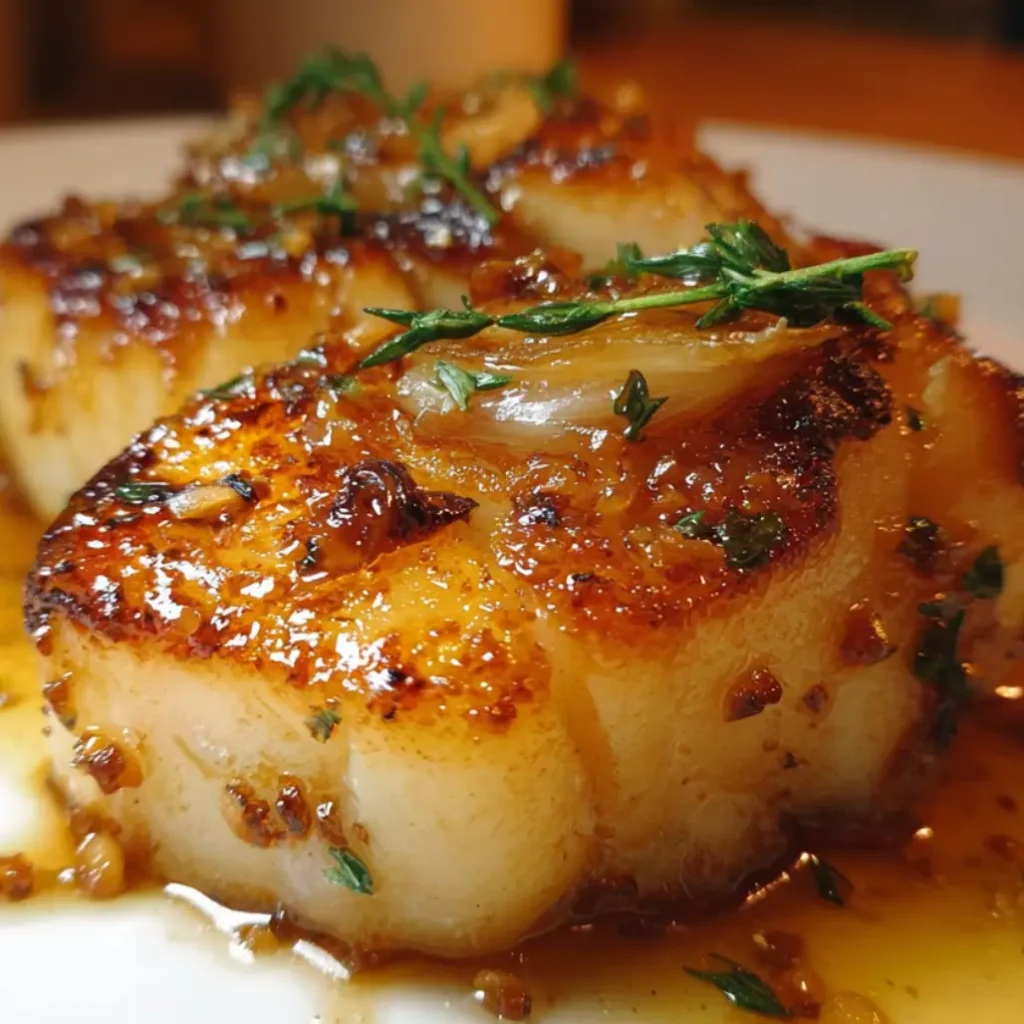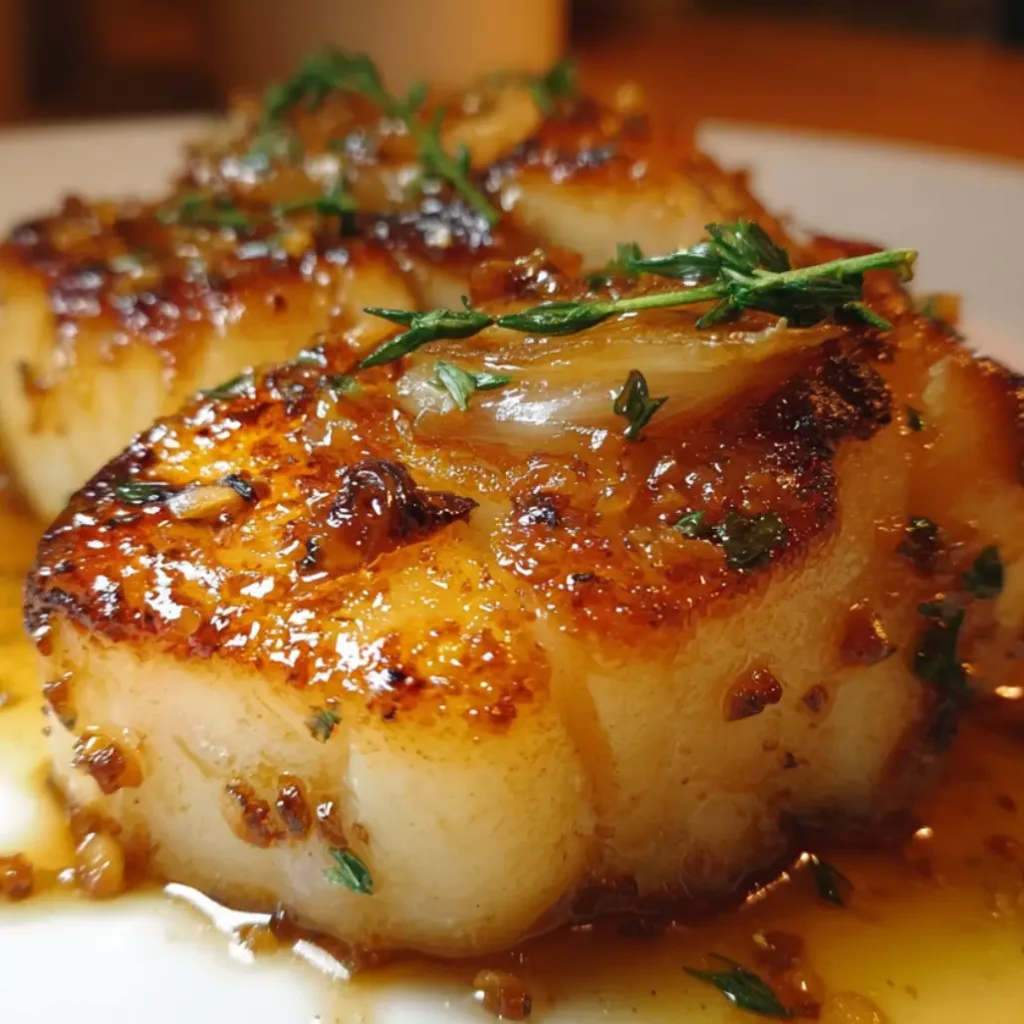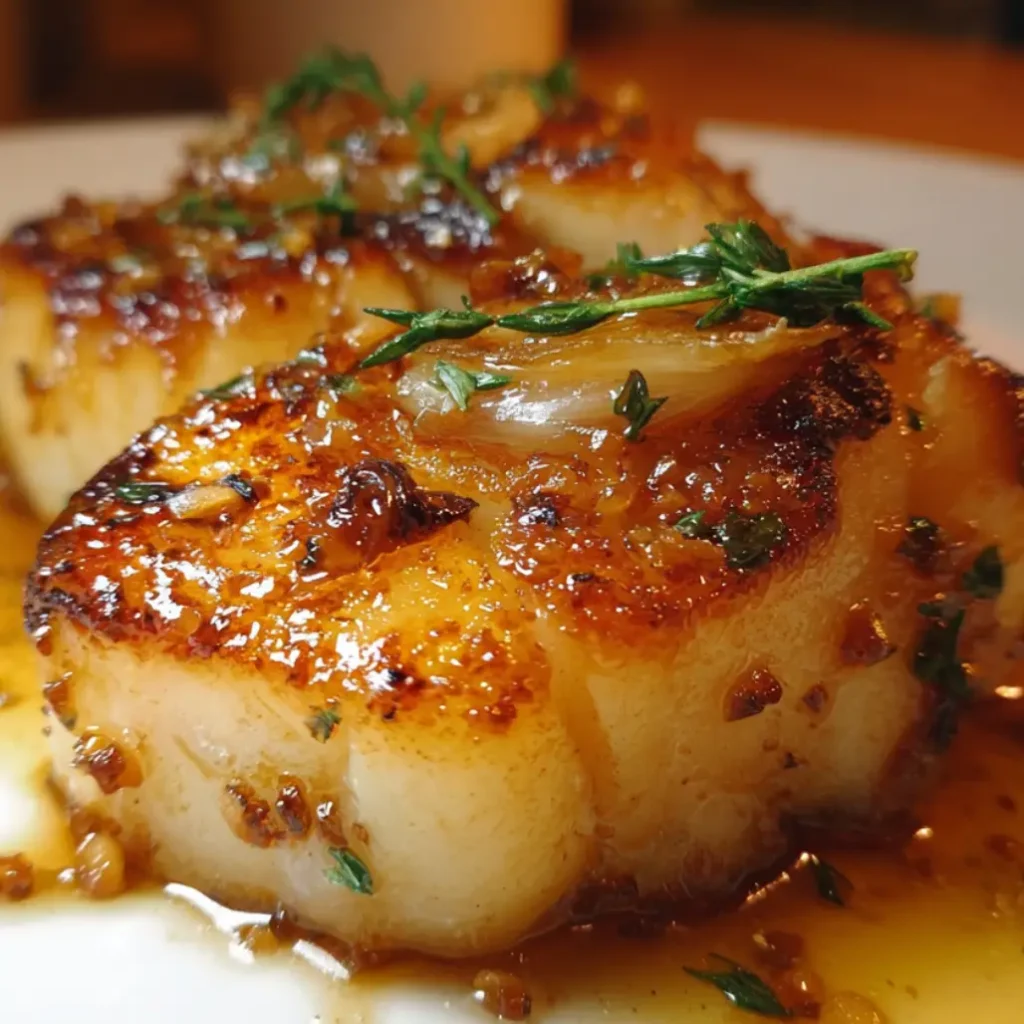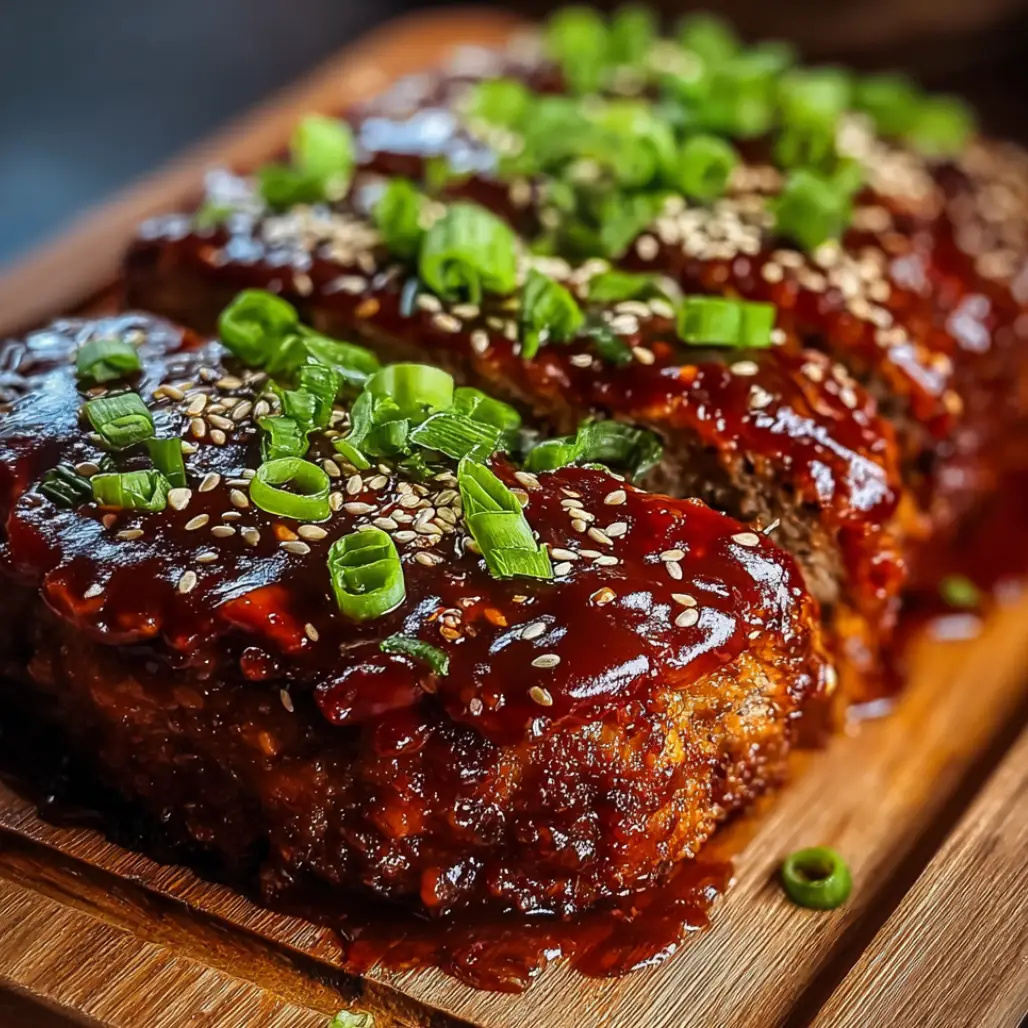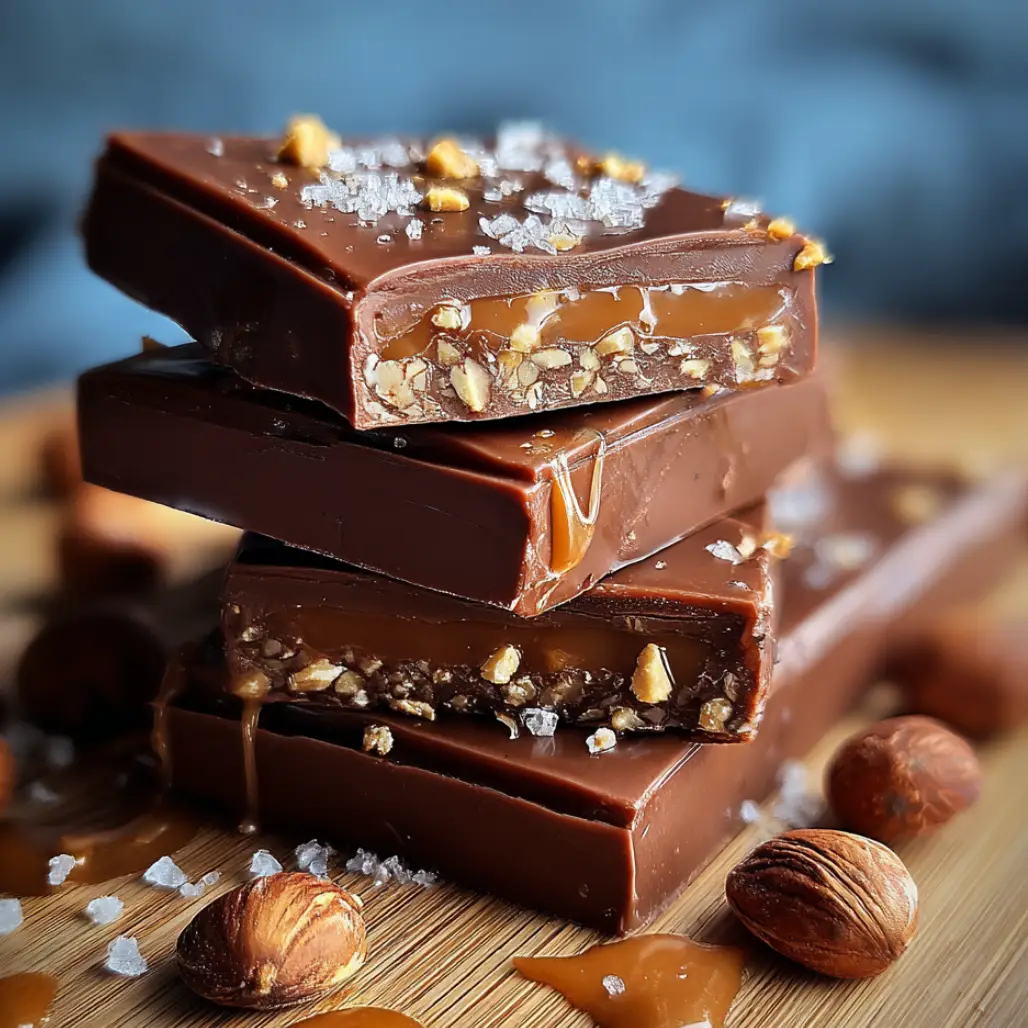| Prep Time: 25 minutes | Cook Time: 12 minutes | Total Time: 37 minutes | Serves: 4 |
|---|
There’s something absolutely magical that happens when sweet honey meets tender, flaky cod in perfect harmony, creating a dish that transforms your regular weeknight dinner into an extraordinary culinary experience. This baked honey marinated cod recipe delivers restaurant-quality flavors right from your home kitchen because it combines the natural sweetness of honey with savory elements that enhance the delicate taste of fresh cod without overwhelming its subtle characteristics. The marinade works its magic by infusing every fiber of the fish with complex flavors that develop during the marinating process, resulting in a dish that’s both sophisticated enough for entertaining and simple enough for busy weeknights.
Why This Baked Honey Marinated Cod Recipe Works
The beauty of this baked honey marinated cod recipe lies in its perfect balance of sweet, salty, and umami flavors that work together to create a memorable dining experience. Cod’s mild, slightly sweet flavor provides the ideal canvas for the honey marinade because its delicate texture absorbs the marinade beautifully while maintaining its natural taste profile. The honey doesn’t just add sweetness; it also helps caramelize the surface of the fish during baking, creating an appealing golden-brown finish that seals in moisture and enhances the overall presentation.
What makes this recipe particularly successful is the strategic use of complementary ingredients that enhance rather than mask the cod’s natural flavors. The combination of honey with soy sauce creates a perfect sweet-savory balance, while the addition of fresh ginger and garlic provides aromatic depth that elevates the entire dish. The acid component from rice vinegar or lemon juice helps tenderize the fish while brightening the overall flavor profile, preventing the honey from making the dish overly sweet.
The baking method ensures even cooking throughout the fillet because the gentle, consistent heat of the oven allows the fish to cook through without drying out or becoming tough. Unlike pan-frying or grilling, baking preserves the cod’s delicate texture while allowing the marinade to penetrate deeply into the fish, resulting in maximum flavor in every bite.
Essential Ingredients for Perfect Honey Marinated Cod
Fresh cod fillets (1.5 pounds, skin removed) – Choose firm, white fillets with no fishy odor for the best results
Raw honey (1/4 cup) – Use high-quality honey for the most complex sweetness and better caramelization
Low-sodium soy sauce (3 tablespoons) – Provides umami depth without overwhelming saltiness
Fresh ginger (2 tablespoons, minced) – Adds warming spice and aromatic complexity
Garlic cloves (3 large, minced) – Creates aromatic foundation and savory depth
Rice vinegar (2 tablespoons) – Balances sweetness and helps tenderize the fish
Sesame oil (1 tablespoon) – Adds nutty richness and authentic Asian flavor
Green onions (3 stalks, chopped) – Provides fresh, mild onion flavor and color contrast
Red pepper flakes (1/2 teaspoon) – Optional heat that complements the sweet marinade
Fresh lime juice (1 tablespoon) – Brightens the overall flavor profile
Kosher salt (1/2 teaspoon) – Enhances all other flavors in the marinade
Black pepper (1/4 teaspoon, freshly ground) – Adds subtle spice and depth
The Art of Creating the Perfect Marinade
Creating the perfect marinade for your baked honey marinated cod recipe requires understanding how each ingredient contributes to the final flavor profile and texture of the finished dish. The marinade serves multiple purposes beyond just flavoring the fish because it also helps tenderize the protein, adds moisture during cooking, and creates the beautiful caramelized exterior that makes this dish so visually appealing.
Start by whisking together the honey and soy sauce until completely smooth, ensuring no lumps remain because any undissolved honey can create uneven sweetness and potentially burn during baking. The honey should dissolve completely into the soy sauce, creating a glossy, amber-colored base that will coat the fish evenly. Add the minced ginger and garlic, whisking vigorously to distribute these aromatic elements throughout the marinade because their flavors need time to meld with the sweet and salty components.
Incorporate the rice vinegar slowly while whisking constantly because the acid will help emulsify the marinade and create a more cohesive mixture. The sesame oil should be added last, whisked in drop by drop to create a stable emulsion that won’t separate during the marinating process. This careful layering of ingredients ensures that each component maintains its distinct characteristics while working harmoniously with the others.
The final marinade should have a balanced sweet-savory flavor with noticeable but not overwhelming ginger and garlic notes. Taste and adjust seasoning as needed because the marinade’s flavor will concentrate slightly during the marinating and cooking process, so it should be well-balanced from the start.
Step-by-Step Instructions for Baked Honey Marinated Cod
Step 1: Prepare the Cod Fillets
Pat the cod fillets completely dry with paper towels because excess moisture will dilute the marinade and prevent proper flavor absorption. Remove any remaining bones with tweezers, running your fingers along each fillet to detect any small pin bones that might have been missed during initial cleaning. Cut the fillets into uniform portions if necessary to ensure even cooking throughout because different sized pieces will cook at different rates.
Professional Tip: Place the cod fillets between paper towels for 10 minutes before marinating to remove any residual surface moisture that could interfere with marinade absorption.
Key Points: Dry fish absorbs marinade better, uniform portions cook evenly, and removing bones ensures a pleasant eating experience.
Step 2: Create the Honey Marinade
Combine the honey, soy sauce, minced ginger, and garlic in a medium bowl, whisking until the honey is completely dissolved because lumpy marinade won’t coat the fish evenly. Add the rice vinegar and continue whisking to create a smooth, cohesive mixture that emulsifies properly. Slowly drizzle in the sesame oil while whisking constantly to prevent separation, then add the lime juice, salt, and pepper.
Professional Tip: Warm the honey slightly in the microwave for 10-15 seconds if it’s too thick to dissolve easily, but let it cool before adding to prevent cooking the garlic and ginger.
Key Points: Proper emulsification prevents separation, dissolved honey ensures even sweetness, and room temperature ingredients blend more easily.
Step 3: Marinate the Fish
Place the cod fillets in a shallow, non-reactive dish and pour the marinade over them, ensuring each piece is completely coated because uneven coverage leads to inconsistent flavors. Turn the fillets to coat all sides thoroughly, then cover the dish with plastic wrap and refrigerate for at least 30 minutes but no longer than 2 hours because longer marinating can make the fish mushy due to the acid content.
Professional Tip: Use a glass or ceramic dish for marinating because metal can react with the acid in the marinade and create off-flavors.
Key Points: Even coating ensures consistent flavor, proper timing prevents texture issues, and non-reactive dishes preserve marinade integrity.
Step 4: Prepare for Baking
Preheat your oven to 425°F and line a baking sheet with parchment paper because this temperature creates the perfect balance between cooking the fish through and achieving caramelization. Remove the cod from the marinade, allowing excess to drip off but leaving enough coating to create the caramelized exterior during baking. Reserve some marinade for basting if desired, but don’t use marinade that has been in contact with raw fish.
Professional Tip: Let the fish come to room temperature for 15 minutes before baking to ensure more even cooking throughout the fillets.
Key Points: Proper temperature is crucial for texture, parchment prevents sticking, and room temperature fish cooks more evenly.
Step 5: Bake to Perfection
Place the marinated cod fillets on the prepared baking sheet, spacing them evenly to allow for proper air circulation because crowded fish won’t brown properly. Bake for 10-12 minutes, depending on thickness, until the fish is opaque and flakes easily with a fork. The internal temperature should reach 145°F for food safety, and the surface should be golden brown from the caramelized honey.
Professional Tip: Check the thickest part of the fillet with an instant-read thermometer to ensure proper doneness without overcooking.
Key Points: Proper spacing ensures even browning, correct temperature guarantees safety, and visual cues help determine doneness.
Step 6: Rest and Serve
Let the baked honey marinated cod rest for 2-3 minutes after removing from the oven because this allows the juices to redistribute and the fish to finish cooking from residual heat. Garnish with chopped green onions and serve immediately while hot because cod is best enjoyed fresh from the oven when its texture is at its peak.
Professional Tip: Squeeze fresh lime juice over the finished fish just before serving to brighten the flavors and add a fresh citrus note.
Key Points: Resting improves texture, immediate serving ensures optimal temperature, and fresh garnishes enhance presentation.
Professional Tips for Exceptional Results
Achieving restaurant-quality results with your baked honey marinated cod recipe requires attention to several key details that separate good fish from exceptional fish. First, always start with the freshest cod available because no amount of marinade can improve fish that’s past its prime. Fresh cod should have clear, bright flesh with no discoloration, a mild ocean scent, and firm texture that springs back when gently pressed.
Temperature control throughout the cooking process is absolutely critical because cod can go from perfectly cooked to overcooked in a matter of minutes. Use an instant-read thermometer to monitor the internal temperature, aiming for exactly 145°F because this ensures the fish is safe to eat while maintaining its delicate, flaky texture. Remove the fish from the oven just before it reaches the target temperature because it will continue cooking from residual heat.
The marinade’s consistency and balance directly impact the final dish’s success because too much acid can make the fish mushy while too little won’t provide enough flavor penetration. Taste the marinade before using it and adjust the honey-to-soy sauce ratio based on your preference, keeping in mind that the flavors will concentrate during cooking.
Consider the thickness of your cod fillets when determining cooking time because thicker pieces require longer baking while thinner pieces cook more quickly. Uniform thickness across all fillets ensures even cooking, so consider butterflying very thick pieces or choosing fillets of similar size.
Creative Variations to Explore
Transform your basic baked honey marinated cod recipe into exciting new dishes by incorporating different flavor profiles and cooking techniques that showcase the versatility of this preparation method. For a Mediterranean twist, replace the Asian-inspired ingredients with honey, lemon juice, olive oil, fresh herbs like thyme and oregano, and a touch of white wine because these flavors complement cod’s delicate taste beautifully.
Create a tropical variation by adding pineapple juice to the marinade along with fresh cilantro, lime zest, and a pinch of cayenne pepper because the fruit’s natural enzymes help tenderize the fish while adding bright, sweet flavors. This version pairs wonderfully with coconut rice and grilled vegetables for a complete island-inspired meal.
For those who enjoy bolder flavors, try a spicy honey-sriracha version by incorporating sriracha sauce, rice wine vinegar, and fresh mint into the basic marinade because the heat complements the sweetness while the mint adds a refreshing finish. Pair these creative variations with complementary sides from https://solushrecipes.com/category/savory-sides/ to create complete, well-balanced meals.
Consider protein substitutions like salmon, halibut, or even chicken breast because the marinade works beautifully with other proteins, though cooking times will need adjustment based on the protein’s density and thickness. Each protein brings its own characteristics to the dish while benefiting from the honey marinade’s flavor-enhancing properties.
Perfect Pairing Ideas
The sweet-savory profile of baked honey marinated cod recipe pairs beautifully with a variety of side dishes and beverages that complement rather than compete with the fish’s delicate flavors. Steamed jasmine rice provides the perfect neutral base because it absorbs any extra marinade while adding satisfying substance to the meal. For a more nutritious option, try quinoa pilaf with fresh herbs or wild rice with toasted almonds.
Vegetable pairings should focus on clean, bright flavors that won’t overpower the cod’s subtle taste. Roasted asparagus with lemon, steamed broccoli with garlic, or sautéed bok choy with ginger all provide excellent textural contrast while maintaining flavor harmony. Consider preparing a fresh Asian slaw with cabbage, carrots, and a light sesame dressing because the crisp vegetables provide a refreshing counterpoint to the rich, caramelized fish.
For beverages, choose options that complement the honey’s sweetness without competing with it. A crisp Sauvignon Blanc or Pinot Grigio provides bright acidity that cuts through the honey’s richness, while a light lager or wheat beer offers a casual, refreshing pairing. Non-alcoholic options like iced green tea or sparkling water with lime provide cleansing properties that enhance the dining experience. Explore more beverage options at https://solushrecipes.com/category/refreshing-beverages/ for additional pairing inspiration.
Discover More Delicious Combinations
Expand your culinary repertoire by exploring complementary dishes that work harmoniously with your baked honey marinated cod recipe to create memorable dining experiences. Start your meal with light, flavorful appetizers from https://tastymiddles.com/category/snacks-appetizers/ that won’t overwhelm your palate before the main course. Consider serving a fresh cucumber salad or miso soup because these light starters prepare your taste buds for the sweet-savory flavors of the honey-marinated fish.
Build complete meals by incorporating perfectly matched side dishes from https://tastymiddles.com/category/perfect-sides/ that enhance the overall dining experience. Coconut rice, sesame green beans, or honey-glazed carrots all complement the fish’s flavor profile while adding variety to your plate. These sides work together to create a cohesive meal where each component supports and enhances the others.
Create themed dinner parties by serving your honey marinated cod alongside other Asian-inspired dishes that share similar flavor profiles. Consider adding spring rolls, edamame, or a light cucumber salad because these dishes maintain the meal’s cohesive theme while providing textural variety. For marinades and flavor enhancers that complement this style of cooking, explore options at https://solushrecipes.com/category/flavored-dips-marinades/ to discover new ways to enhance your seafood preparations.
Storage and Reheating Guidelines
Proper storage of your baked honey marinated cod recipe ensures food safety while maintaining the best possible quality for later consumption. Cooked cod should be refrigerated within two hours of cooking and can be safely stored for up to three days in the refrigerator because seafood is more perishable than other proteins and requires careful handling to prevent spoilage.
Store leftover cod in airtight containers to prevent absorption of other flavors and to maintain moisture because exposed fish quickly becomes dry and loses its appealing texture. If you plan to freeze portions, wrap individual servings tightly in plastic wrap before placing in freezer bags, removing as much air as possible to prevent freezer burn because properly wrapped fish can maintain quality for up to three months.
Reheating requires gentle methods to prevent the delicate fish from becoming tough or dry. The oven method works best: preheat to 275°F, place the fish in a covered baking dish with a tablespoon of broth or water, and heat for 10-15 minutes until warmed through. Microwave reheating should be done at 50% power in 30-second intervals because high heat can make cod rubbery and unpalatable.
For best results, consider flaking leftover cod and incorporating it into salads, pasta dishes, or fish cakes because these preparations can actually benefit from the concentrated flavors that develop during storage. This approach transforms leftovers into completely new meals while maximizing the honey marinade’s flavor investment.
The Science Behind Perfect Honey Marinated Cod
Understanding the scientific principles behind your baked honey marinated cod recipe helps you achieve consistent, exceptional results every time you prepare this dish. The marinade works through several chemical processes that transform both the texture and flavor of the fish because acids, enzymes, and salt all contribute to the tenderizing and flavoring process.
Honey’s natural enzymes begin breaking down proteins immediately upon contact, which is why longer marinating times can result in mushy texture if overdone. The optimal marinating time of 30 minutes to 2 hours allows for flavor penetration without compromising the cod’s delicate structure because the fish’s proteins need time to absorb flavors without being over-tenderized by the acidic components.
The Maillard reaction occurs when the honey’s sugars interact with the fish’s proteins under heat, creating the appealing golden-brown color and complex flavors that develop during baking. This reaction is temperature-dependent, which is why the 425°F baking temperature is crucial because lower temperatures won’t trigger adequate browning while higher temperatures might burn the sugars before the fish cooks through.
The combination of salt from the soy sauce and acid from the rice vinegar creates an environment where flavors penetrate more deeply into the fish’s cellular structure because these compounds help break down the protein matrix, allowing the marinade’s components to infuse throughout the fillet rather than just coating the surface.
Troubleshooting Common Issues
Even experienced cooks occasionally encounter challenges when preparing baked honey marinated cod recipe, but understanding common problems and their solutions ensures consistent success with this dish. If your cod turns out dry, the most likely cause is overcooking because fish continues cooking even after removal from the oven due to residual heat. Always err on the side of slight undercooking and allow carryover heat to finish the process.
Mushy or mealy texture typically results from over-marinating because the acid in the marinade breaks down the fish’s protein structure when left too long. Stick to the recommended marinating time and use a timer to prevent accidentally leaving the fish in the marinade too long. If your fish consistently turns out mushy, reduce the marinating time or dilute the acid content slightly.
Uneven browning often occurs when the baking sheet is overcrowded or the oven temperature is incorrect because proper air circulation is essential for even caramelization. Use a larger baking sheet if necessary and verify your oven temperature with an independent thermometer because many ovens run hot or cold, affecting cooking results.
If the honey burns before the fish cooks through, your oven temperature is likely too high or the fish is positioned too close to the heating element because honey’s sugars caramelize quickly at high temperatures. Lower the temperature to 400°F and move the fish to a lower rack position to prevent burning while ensuring thorough cooking.
Additional Inspirations for Your Culinary Journey
Expand your seafood cooking repertoire by exploring complementary recipes that build upon the techniques and flavors you’ve mastered with this baked honey marinated cod recipe. Consider trying other white fish preparations that use similar marinade principles but showcase different flavor profiles because mastering one technique opens doors to countless variations.
Salmon responds beautifully to honey marinades but requires different timing due to its higher fat content and denser texture because these characteristics affect how the fish absorbs flavors and cooks. Experiment with maple-glazed salmon or honey-soy Arctic char to discover how different fish varieties interact with sweet marinades.
For complete meal planning, consider breakfast dishes that complement your seafood skills because morning meals offer opportunities to practice similar techniques with different ingredients. Explore options at https://solushrecipes.com/category/breakfast-favorites/ to find recipes that build upon your marinade and baking expertise while expanding into new meal categories.
Create dessert connections by preparing honey-based desserts that echo the sweetness in your main dish because cohesive flavor themes throughout a meal create more memorable dining experiences. Browse https://tastymiddles.com/category/dessert-recipes/ for honey-forward desserts that complement your seafood-focused meals while satisfying your sweet tooth.
Don’t forget to incorporate fresh, vibrant salads that provide textural and flavor contrast to your honey-glazed fish because the combination of warm, caramelized protein with crisp, fresh vegetables creates perfect meal balance. Discover complementary salad recipes at https://tastymiddles.com/category/salads/ that pair beautifully with your honey marinated cod preparations.
Conclusion
This baked honey marinated cod recipe represents the perfect intersection of simplicity and sophistication because it transforms humble ingredients into an extraordinary dining experience that satisfies both novice and experienced home cooks. The sweet-savory balance achieved through careful marinade construction creates a dish that’s versatile enough for casual weeknight dinners yet elegant enough for special occasions and entertaining.
The techniques you’ve learned here extend far beyond this single recipe because understanding how marinades work, proper fish handling, and optimal baking methods provides you with skills that apply to countless other seafood preparations. These fundamental concepts become building blocks for culinary creativity, allowing you to experiment confidently with different flavor combinations while maintaining the technical excellence that ensures consistent results.
Most importantly, this recipe demonstrates that exceptional cooking doesn’t require complicated techniques or expensive ingredients because the magic happens when quality ingredients are treated with respect and combined thoughtfully. The honey marinade elevates the cod’s natural flavors rather than masking them, creating a dish that celebrates both the sweetness of the honey and the delicate taste of fresh fish in perfect harmony.

